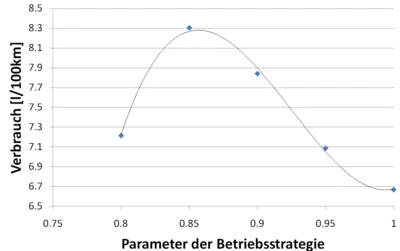Operating strategies for hybrid and electric vehicles
Challenges
Operating strategies are a crucial component of hybrid and electric vehicles. In the case of hybrid vehicles, they are used to select the most energy-efficient type of drive, whereas in the case of electric vehicles they are essentially required to increase the range. If the driving cycle is known, the optimal operating strategy can be determined relatively easily; the challenge is that the distance covered in the real case is usually not known in advance. In addition, the change between the individual modes of the operating strategy should be so smooth that the driver does not notice it. In addition to the driving cycle, the optimal operating strategy is strongly dependent on the powertrain and the size of the individual components.
Goals
We develop operating strategies that are suitable for optimization through their parameterization. By optimizing the entire powertrain and the operating strategy in two stages, we aim to derive the existing dependencies. We also want to develop operation strategies that use prediction to determine the best parameterization while driving.
Steps
Development of an operating strategy for hybrid vehicles
We develop operating strategies based on different approaches and evaluate the areas of application of the different strategies based on the overall vehicle optimization.
Development of an operating strategy for electric vehicles
The prediction of driving situations and activated loads provides a good basis for the development of an operating strategy for electric vehicles.
Optimization of the operating strategy
Changing the parameterization of the operating strategy is a free and very simple modification and is therefore particularly interesting for the automotive industry. The influence that optimizing the operating strategy can have on consumption is shown in Figure 2. The diagram shows that the vehicle's consumption depends strongly on the values of the operating strategy parameters. In this figure, consumption is plotted against the load point boost factor, which describes to what percentage of the maximum torque of the combustion engine the torque is raised when the load point is increased. In this case, the optimum load point increase factor for a 3-cylinder internal combustion engine is 1. It is also noticeable that there is a local maximum of 0.85.
